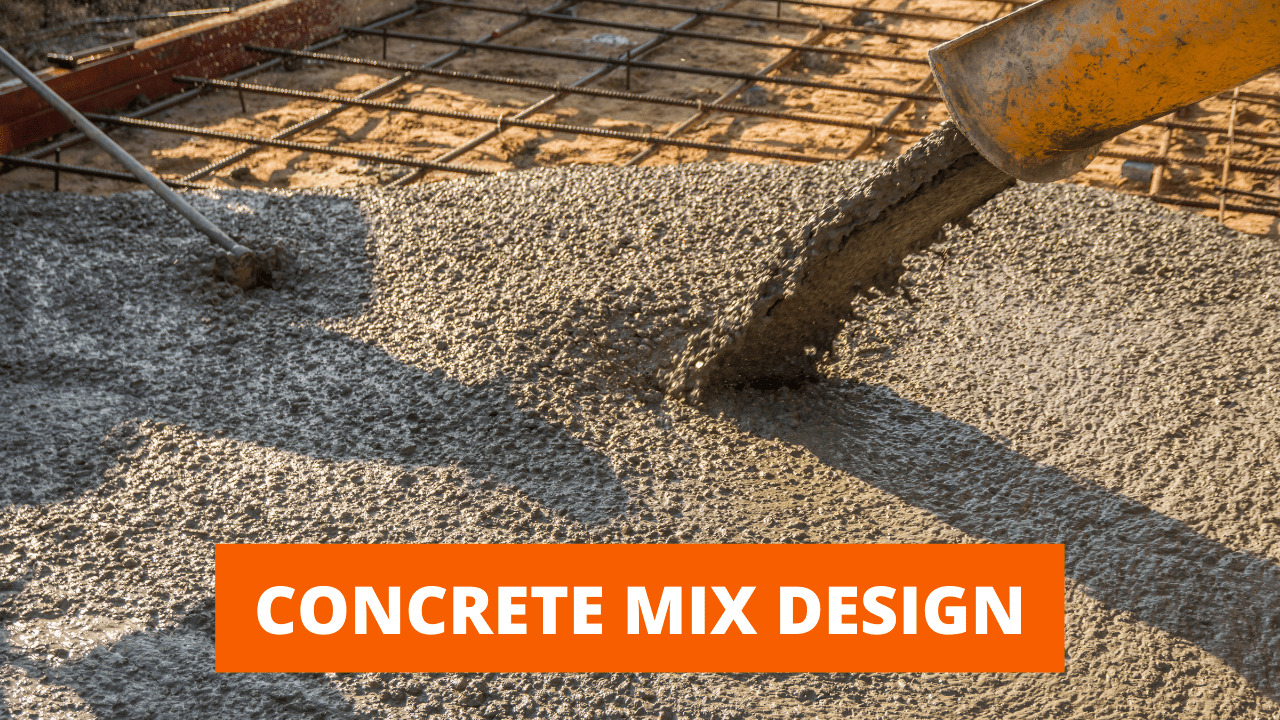Concrete is a sundry mixture of a number of constituents, each of which is added to hit a particular target, be it strength, durability, workability, etc. but the key players in concrete are cement, coarse aggregates, fine aggregates, and water.
However, there might be secondary materials added in concrete to modify its properties as per requirement or site constraints. These may either be admixtures (chemical or air- entraining) or some supplementary cementitious materials.

Fig. 1: Constituents of Normal Concrete
The most important step prior to producing concrete is its mix design that simply means determining the relative proportions of various constituents of concrete that must be mixed to produce a unit volume of wet concrete.
Nevertheless, the procedure is also reliant on the concrete type to be produced and the properties set on goal (such as workability, strength, etc.). A few concrete types are listed below, but for general construction purposes, plain cement concrete (PCC) or reinforced cement concrete (RCC) is used.
- Plain Cement Concrete
- Reinforced Cement Concrete
- Precast Concrete
- Prestressed Concrete
- Self-compacting Concrete
- Air-entraining Concrete
- Lightweight Concrete
- High-Density Concrete
Table of Contents
Types of Concrete Mix Designs
Concrete mix designs are generally of 2 types as explained below;
1)Nominal Concrete Mix:
These mixes are prepared following standard codes used for construction-related activities. Therefore, these mixes have margin for errors, quality control and wastage.
2) Design Concrete Mix
Design concrete mixes propose the relative proportion of cement, sand, crushed stones and water while considering the actual quality of materials and their experimentally-determined properties.
Procedure for Normal Concrete Mix Design
The ‘American Concrete Institute’ (ACI) has provided ample guidelines for the mix design of concrete depending upon the type to be used. Nonetheless, the design approach has some prior stipulations followed by a complete mix design process. The steps involved for mix design of normal weight concrete are detailed below:
Step 1: Prerequisite Properties
The first step of design procedure is to specify some parameters that relate with the properties of concrete constituents. The requisite properties are mentioned below,
- Loose and compacted bulk density of coarse and fine aggregates. This is determined following the guidelines of ASTM C29/ C29M-17 a.
- Fineness modulus of aggregates. This is determined using ASTM C136.
- Specific gravity of aggregates
- Water absorption of aggregates
- Cement to be used should comply with the specifications of ASTM C150.
Step 2: Defined Parameters
A few parameters are either code-specified or are assumed prior to the actual mix design. These parameters include,
- Slump Value: A value of slump is to be taken initially depending upon the type of construction. This value of slump is a choice made for the workability of concrete mix. Even in this regard, ACI has provided some general guidelines in Appendix 1, ACI 211.1 as given in the following table.
| Type of Construction | Slump (mm) |
(Inch) |
|---|---|---|
| Reinforced Foundation Walls and Footings | 25–75 | 1–3 |
| Plain footing, caissons and sub-structure walls | 25–75 | 1–3 |
| Beams and reinforced walls | 25–100 | 1–4 |
| Building columns | 25–100 | 1–4 |
| Pavements and slabs | 25–75 | 1–3 |
| Mass concrete | 25–50 | 1–2 |
Source: Appendix 1, ACI 211.1
- Maximum Aggregate Size: ACI generally recommends the maximum aggregate size to be limited to 1/3 of the depth of slab and 3/4 of the minimum clear space between the steel reinforcing bars. The choice of maximum aggregate size is likely to affect the workability and strength characteristics of concrete as well as the ease of its compaction. It is also to be kept in mind that the maximum aggregate size affects the slump value.
Step 3: Estimated Parameters
The parameters such as mixing water content and air content are tentatively determined using the slump and nominal maximum aggregate size decided in step 2.
These tentative values are also dictated by ACI Tables as given below, however, depending upon the target concrete properties, the choice between air-entrained concrete and non-air-entrained concrete is to be made.
- Air-entrained concrete has air deliberately in it. During freezing, the volume increases and concrete expands, as a result, the entrained air helps in releasing stresses due to expansion. This concrete type is predominantly used in areas where freeze-thaw resistance is required.
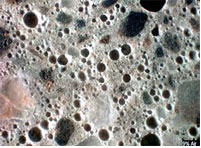
Fig. 2: Air-entraining Concrete
- Non-air-entrained concrete is one in which air is not entrained for freeze-thaw resistance.
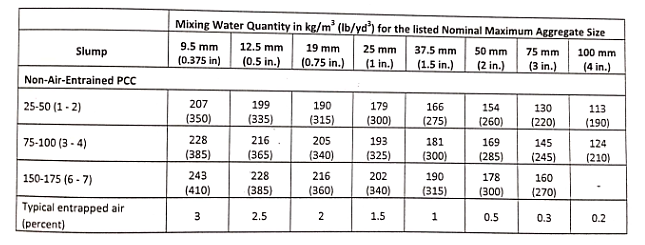

Source: ACI, 2000
Therefore, in step 3 we get the quantity of water in to be added in the mix.
Step 4: Determination of Water-to-Cement Ratio
The initial water/cement ratio is determined from the known value of target compressive strength. It is to kept in mind that the target or required compressive strength is always kept more than the design compressive strength to account for human errors in mix design and batching. The following table gives some guidelines for determining the target strength.


Source: ACI: 211.1:1991
It is probable that the target compressive strength value is not directly available in the table above. In that case we can either interpolate between the two values to get the exact water/cement ratio or we may plot a curve using the above data and extract value from it.
The importance of finding the exact W/C ratio is to avoid over-estimation or under-estimation of water. The graph between the target strength and W/C ratio for non-air-entrained concrete is given below;
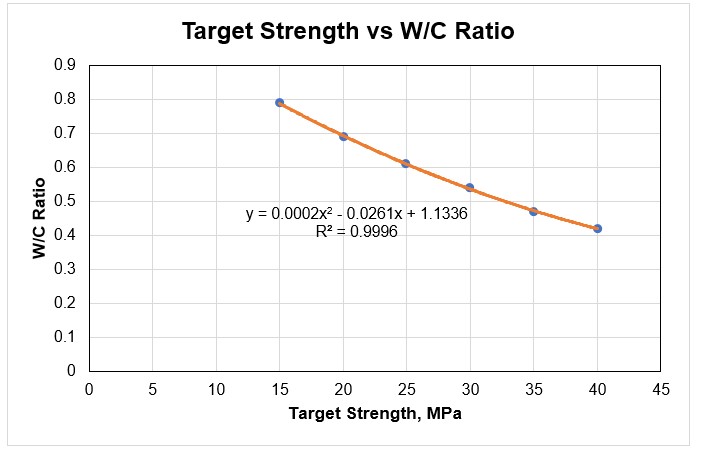
Knowing the target strength, the equation in terms of y gives the initial W/C ratio to be taken for further calculations.
Step 5: Determination of Cement Content
Cement content is determined based on the initial water-to-cement ratio determined in the previous step.

Step 6: Determination of Coarse Aggregate Content
The volume of coarse aggregates per cubic meter of concrete is determined using the volume of coarse aggregates per unit volume (given by ACI 211.1, Appendix 1) and the rodded bulk density of coarse aggregates already known.
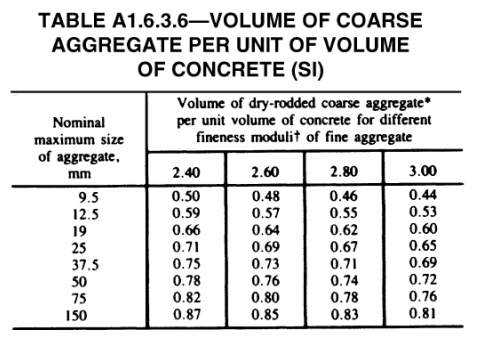
Source: ACI: 211.1:1991

The values of volume of coarse aggregates per unit volume may be interpolated in case the exact value is apparently missing in the table.
Step 7: Determination of Fine Aggregate Content
Till this step, the volume of all the other components of concrete (water content, cement content, coarse aggregate content, air content) is known for volume of concrete. Therefore, the volume of fine aggregates can be determined as:

Step 8: Adjustments for Water Absorption by Aggregates
The water that is added in the dry mix, a part of it is actually absorbed by the aggregate particles too. This water becomes unavailable for concrete mixing and achievement of workability. Therefore, it must be accounted for in the calculations to prevent a net change in the available water for mixing operations.
Therefore, we need to determine the water absorbed by coarse and fine aggregates.
Water absorbed by aggregates=water absorption × weight of aggregates
The total water to be added therefore, is the sum of absorbed water and mixing water calculated initially. It is to be kept in mind that the W/C ratio is not changed, instead, additional amount of water that is to be absorbed by aggregates is calculated and added to the mixing water.
This is because changing W/C ratio indirectly changes the target strength, which in no case is intended. In addition, changing water content also alters the amount of cement to be added proportionally, hence, the absorbed water in no case should contribute in deciding the cement content.
However, if the aggregates are used in ‘saturated surface dry’ (SSD) condition, the adjustment for water is to be omitted and the calculated mixing water is finally reported.
Step 9: Final Weights of Constituents
Finally, the weight of all components of concrete per unit volume become known. These weights may be batched by volume or mass to produce wet concrete which is later cast for desired purposes.
The mix design process also lends us a mix ratio that defines the parts of sand and crushed stones to be added for 1 part of cement. It is generally expressed as;
Mix Ratio = Cement : Fine Aggregates : Coarse Aggregates
For example, a mix design ratio of 1:2:4 indicates that for 1 part of cement, we have 2 parts of sand and 4 parts of crushed stones. These parts may have any mass unit (kg, lb. etc.)
‘Mix Design Summary’
| Known | Design Compressive Strength, f’c Target Compressive Strength, f’cr Type of Cement to be Used |
| Determined | Suggested Amount of Water Air Content Water Content Bulk Volume of Aggregate (m3/m3) |
| Calculated | Cement (kg/m3) Weight of Coarse Aggregates (kg/m3) Weight of Fine Aggregates (kg/m3) Water Absorption Adjustment (kg/m3) Weight of Components (kg) |
| Final Concrete Mix | ||
| Cement | Fine Aggregate | Coarse Aggregate |
| Mix Ratio |
Effects of Chemical Admixtures on Concrete Proportions
Admixtures may be added in concrete before or during the mixing operation to modify the properties as per requirement. ASTM standard has specified 7 chemical admixtures types based on the properties they impart to concrete. These are given in the adjoining table.
The dosage of admixtures should be taken considering the manufacturer’s recommendations. Additionally, these admixtures also tend to affect the water requirement in concrete. Therefore, ASTM C494 must be consulted while finalizing the dosages.
| Type A | Water Reducing |
| Type B | Retarding |
| Type C | Accelerating |
| Type D | Water-reducing and retarding |
| Type E | Water-reducing and accelerating |
| Type F | Water-reducing, high-range |
| Type G | Water-reducing, high-range, and retarding |
Source: ASTM C494
Some Concrete Grades as per ACI Code
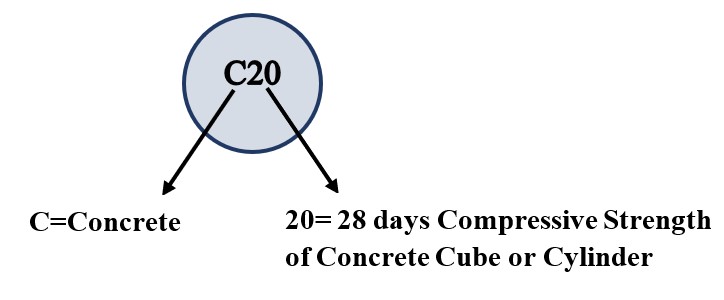
| Grade | Compressive Strength | Grade | Compressive Strength |
| C10 | 10 | C25 | 25 |
| C12 | 12 | C28 | 28 |
| C15 | 15 | C30 | 30 |
| C18 | 18 | C35 | 35 |
| C20 | 20 | C40 | 40 |
| C22 | 22 | C50 | 50 |

